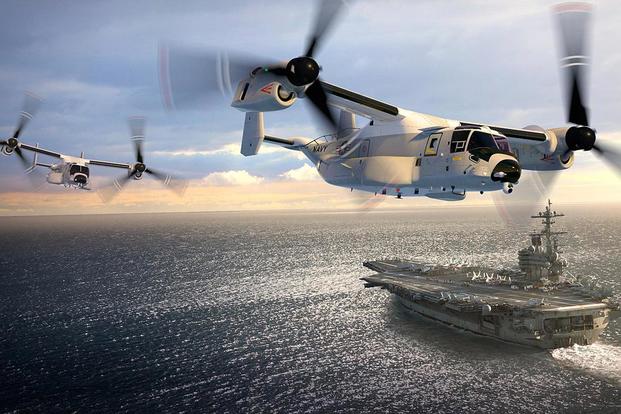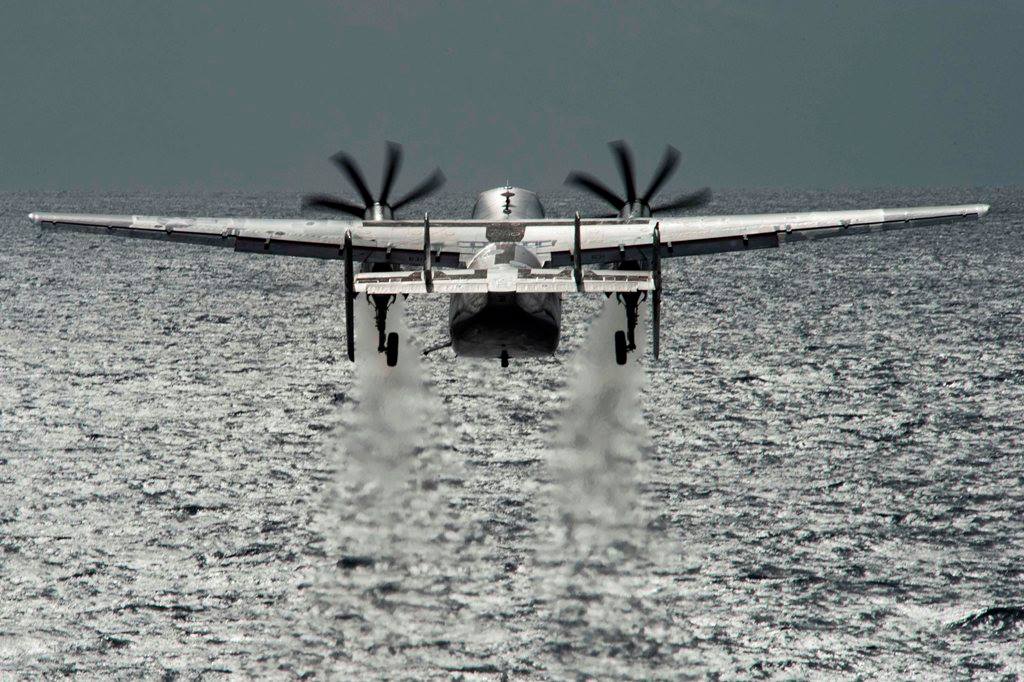
The Navy has accelerated the sunset of its legacy C-2A Greyhound cargo airplanes and the transition to the CMV-22B Osprey, with the new tiltrotor aircraft now set to deliver in Fiscal Year 2020 and deploy in 2021.
The variant of the Marines’ MV-22B Osprey leverages a hot production line and will be able to go through a shorter testing process due to being so similar to an in-use aircraft. In fact, a contract awarded in June covers the final Marine MV-22s as well as the first 39 CMV-22s that will serve as the next-generation carrier-onboard delivery (COD) aircraft.
During a House Armed Services seapower and projection forces subcommittee hearing on Friday, Rear Adm. Scott Conn, director of air warfare on the chief of naval operations’ staff (OPNAV N98), told lawmakers that the transition was already happening as fast as possible.
“We have accelerated the sundown of the C-2 from 2027 to 2024. We have our first (CMV-22B) aircraft being built in Philadelphia today, going down the line. That aircraft will deliver in FY 20. We then have to do a modified [operational test] and [developmental test] and the only thing … we’re testing are the things different on the CMV-22 as compared to the MV-22. So that’s going to be a very compressed test,” Conn said.
“We then [reach initial operational capability] and get our first three aircraft to deploy in 2021. There is no means by which I can accelerate that any further. When you look at the [military construction], the training that’s required for our sailors to operate and maintain and the aircrew that have to fly it and get the hours they need, we’re going as fast as we can go.”
There are three main differences in the CMV-22B compared to the Marines’ MV-22B. The Navy’s aircraft will have an extended-range fuel system, a high-frequency beyond line-of-sight radio and a public address system in the back of the aircraft.
Due to the similarity in the aircraft, the Navy has already begun training with the Marines’ Osprey, with an all-Navy crew flying a V-22 for the first time in July.
Conn had been asked if there were additional funds the Navy needed to help get out of the legacy C-2s faster, and he said that, on the back end of the transition, “any additional aircraft at this point would relieve or provide a shock absorber during the transition, as we go from transition to deployment in follow-on detachments until we’re completely divested of our C-2.”

Subcommittee ranking member Rep. Joe Courtney (D-Conn.) had asked about additional funds for the CMV-22B program, noting that the C-2A fleet was aging and facing diminished operational availability. Conn said the planes were 30 years old and were “nowhere near where we want it to be” in terms of operational availability. Investments in aviation readiness yielded some improvement, with the planes hitting 40-percent operational availability in 2018 compared to just 32 percent in 2017, but he noted that wasn’t good enough to support a globally deployed fleet.
Despite the readiness challenges within the C-2A fleet, the planes had had an impressive record of safety until one crashed in the Philippine Sea in November 2017. The plane, from the forward-deployed Detachment 5 of the “Providers” of Fleet Logistics Support Squadron (VRC) 30, had 11 passengers and crew onboard – eight were safely recovered and three died in the crash.
The Navy located the wreckage of the plane in January after sending a salvage ship in December, but Conn said in the hearing that the plane may not be lifted from the sea floor until next summer.
“Our recovery and salvage efforts: we have the 22,000 feet of Kevlar cable to recover the aircraft that is at 18,000 feet of water in the Philippine Sea. We have to do some follow-on testing with the winch and the salvage vessel to be able to reel up this aircraft,” he said.
“And then now that we’re in typhoon season in that part of the world, we’re going to have to wait for the seas to abate. Our best estimate right now is, when we look at the conditions the ocean will provide, we’re looking late spring, early summer of next year.”
The investigation into that crash is still ongoing, he said.





